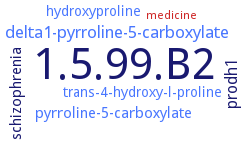1.5.99.B2: proline dehydrogenase (acceptor)
This is an abbreviated version!
For detailed information about proline dehydrogenase (acceptor), go to the full flat file.

Reaction
Synonyms
APE_1267.1, dye-linked L-proline dehydrogenase, L-proDH, L-proline dehydrogenase, L-proline: FAD oxidoreductase, L-proline:FAD oxidoreductase, LPDH, PDH, PDH1, PDH2, PF1246, PF1798, PH1364, PH1751, PIG6, POX, Pro dehydrogenase, PRODH, ProDH1, ProDH2, proline dehydrogenase, proline oxidase, prub, PutA, TK0117, TK0122, TPpdhB, TPpdhB2, TtProDH
ECTree
Advanced search results
Source Tissue
Source Tissue on EC 1.5.99.B2 - proline dehydrogenase (acceptor)
Please wait a moment until all data is loaded. This message will disappear when all data is loaded.
expression levels of ProDH2 are generally low, but increase in senescent leaves and in the abscission zone of floral organs

additional information
expression levels of ProDH2 are generally low, but increase in senescent leaves and in the abscission zone of floral organs

expression levels of ProDH2 are generally low, but increase in senescent leaves and in the abscission zone of floral organs



 results (
results ( results (
results ( top
top






